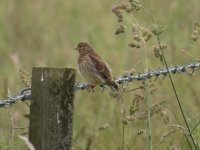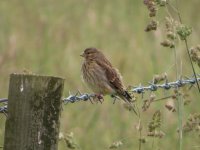-
Welcome to BirdForum, the internet's largest birding community with thousands of members from all over the world. The forums are dedicated to wild birds, birding, binoculars and equipment and all that goes with it.
Please register for an account to take part in the discussions in the forum, post your pictures in the gallery and more.
You are using an out of date browser. It may not display this or other websites correctly.
You should upgrade or use an alternative browser.
You should upgrade or use an alternative browser.
linnet or twite, Scotland (1 Viewer)
- Thread starter marnixR
- Start date
More options
Who Replied?Southern Frogmouth
Well-known member
It is a Linnet.
Cheers
Roy
Cheers
Roy

Yes, a young linnet.
Alexander Stöhr
Well-known member
I'm discovering that the the answer to "is it a Linnet or Twite" is pretty much always "It's a Linnet"
I think a possible explanation is the following: most of the times both are easy distinguished by colours alone: linnet has a grey head and warm rufous brown back. While Twites are drabber/colourless brown birds with the right orange-buff face (and breast). This works most times and is one reason, why ID-books put so much weight in this "Twite-coloured-face".
Imagine, you see hundreds of Twites and adult Linetts and become confident in jizz identification by colour alone.
And then you see your first 1 cy (rarely older) Linnet with very similar warm orange buff tones (and sometimes nearly perfect hues in the supercilium and below eye).
You are puzzled, because you get a Twite-feeling but something seems not quite right.
This answer leaves out:
Twites with drab plumage, lacking the Twite-orange-buff face and throat, but with a bold contrasting white/warm buff wingbar (and sometimes bold white wing patch) as the only contrasting markings.
Last edited:
Deb Burhinus
Used to be well known! 😎

I'm discovering that the the answer to "is it a Linnet or Twite" is pretty much always "It's a Linnet"
Because it usually is unless you’re in Scotland where Twite are also very possible - It’s pretty much down to distribution pianoman - take a look at these Atlas links showing distribution of Twite in the UK compared to Linnet.
You will see Twite are predominately clustered in Scotland while Linnet are pretty much widespread throughout the British Isles although a bit more localised in some parts of Scotland - the differences in range and populations size between Twite and Linnet are not always appreciated!
Twite
https://app.bto.org/mapstore/StoreServlet?id=474
Linnet
https://app.bto.org/mapstore/StoreServlet?id=473
Of course the 08-11 Atlas doesn’t include recent population declines either
more here
https://www.birdguides.com/articles/identification/linnet-and-twite/
Last edited:

My experience in Scotland is that they're still usually Linnets.

Almost all birders in Scotland would also consider twite to be an excellent tick. They're really only found in any numbers in places where humans aren't found in any numbers.
Deb Burhinus
Used to be well known! 😎

They're really only found in any numbers in places where humans aren't found in any numbers.
I agree - most of the Twite I’ve seen in Scotland have been in the Western Isles - I’ve also seen non-breeders on the South Coast of England but in very low numbers - so there is still a higher possibility of seeing Twite in Scotland than the rest of the UK even though population size difference means the probability of a Linnet sighting is much higher anywhere in the UK (perhaps that didn’t come across very well in my post? but the Atlas speaks for itself in this respect.)
marnixR
WYSIWYG
I agree - most of the Twite I’ve seen in Scotland have been in the Western Isles - I’ve also seen non-breeders on the South Coast of England but in very low numbers - so there is still a higher possibility of seeing Twite in Scotland than the rest of the UK even though population size difference means the probability of a Linnet sighting is much higher anywhere in the UK (perhaps that didn’t come across very well in my post? but the Atlas speaks for itself in this respect.)
that's where I've my one time of seeing a twite - at Tolsta north of Stornoway
I can see from the distribution maps that a sighting is less likely near Montrose
Nutcracker
Stop Brexit!
More a matter of inland / coastal, than England / Scotland. Plenty of English coasts get wintering Twite too, from Northumbs down to Norfolk and also the Lancs coast, but they are very strongly coastal - Twite is a rarity anything more than a couple of hundred metres inland. Saltmarsh and dunes are their favoured habitats. You can get coastal Linnets too, but they tend to seek out the slightly more sheltered spots with a few bushes, rather than the bleak bits Twite like.
Different in the breeding season, when Twite can occur in mountain districts.
Different in the breeding season, when Twite can occur in mountain districts.
Deb Burhinus
Used to be well known! 😎

More a matter of inland / coastal, than England / Scotland. Plenty of English coasts get wintering Twite too, from Northumbs down to Norfolk and also the Lancs coaststs.
Would be interested to see population maps you are using for that proposition Nutcracker - I’ve only seen small numbers of non-breeding Twite (in coastal habitat ) in coastal regions outside Scotland.
The Breeding and Winter Bird Atlas that I linked to above supports the proposition that both wintering and breeding Twite are predominantly in Scotland unless you have some other papers or population density maps you could refer us to?
Don’t forget, ‘distribution’ is not the same as ‘density’ and there is no way you can claim there is an equal chance of getting Twite on the Coast of Norfolk as there would be on Western Scottish Coasts or the on Northern Isles for example or that the density of Twite in Scotland is the same as it is in the rest of the UK (be it inland or coastal).
Btw the highest cluster of Twite outside Scotland is in the South Pennines - (as ringing recoveries will attest to) breeding and non-breeding - hardly coastal!
Last edited:
Prestdj
its good to be back

Twite is my local bird, I've just this morning seen a group of 30+
Coastal flocks seem to be on the decrease but the breeding area of the south Pennines the birds are staying throughout the winter
At my patch they like thistle heads and bracken and not averse to settling in trees
The only time I don't see them is breeding season very secretive
One colour ringed bird is over 10 years old!
Special bird
Coastal flocks seem to be on the decrease but the breeding area of the south Pennines the birds are staying throughout the winter
At my patch they like thistle heads and bracken and not averse to settling in trees
The only time I don't see them is breeding season very secretive
One colour ringed bird is over 10 years old!
Special bird
Users who are viewing this thread
Total: 2 (members: 0, guests: 2)





